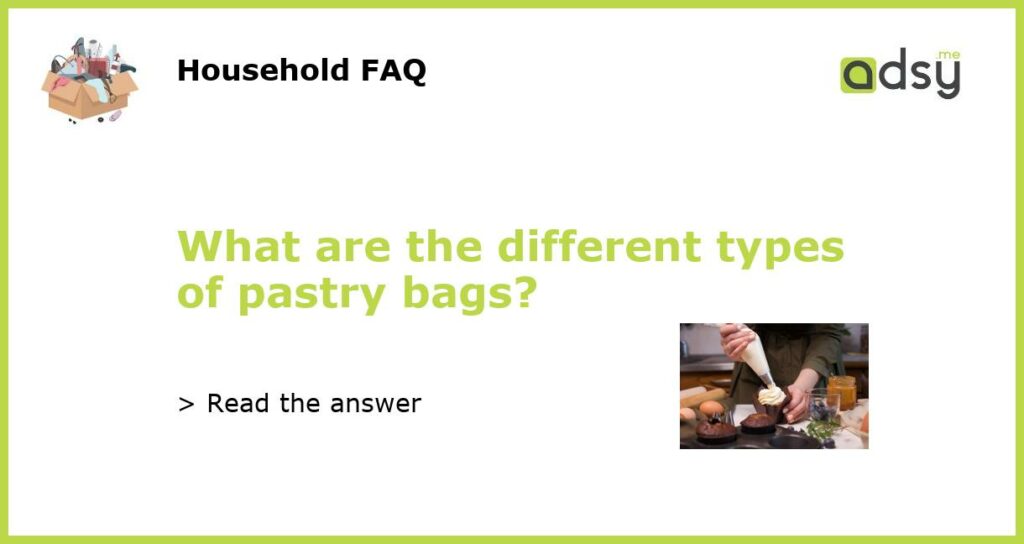Types of Pastry Bags
Pastry bags are indispensable tools for professional chefs and home bakers alike. They allow for precise and controlled piping of ingredients, making it easier to create beautiful and intricate designs. There are several different types of pastry bags available, each with its own unique features and benefits. In this article, we will explore five common types of pastry bags.
Disposable Plastic Pastry Bags
Disposable plastic pastry bags are the most common type of pastry bags used in both professional and home kitchens. These bags are made from thin, lightweight plastic and are designed for one-time use. They are convenient because there is no need for cleaning or maintenance – simply throw them away after use. Disposable plastic pastry bags are also affordable and easily accessible, making them a popular choice for beginners or for those who only pipe occasionally.
One of the main advantages of disposable plastic pastry bags is their flexibility. They can be easily cut to fit a variety of tips and nozzles, allowing for different piping techniques. However, they are not as durable as other types of pastry bags and may burst or tear if too much pressure is applied. Disposable plastic pastry bags are also not environmentally friendly, as they contribute to plastic waste.
Reusable Silicone Pastry Bags
Reusable silicone pastry bags are a more eco-friendly alternative to disposable plastic bags. They are made from food-grade silicone, which is a durable and flexible material. Silicone pastry bags are designed to be used multiple times and are resistant to tearing or bursting. They are also dishwasher safe, making them easy to clean and maintain.
One of the main advantages of silicone pastry bags is their durability. They can withstand high temperatures, making them suitable for both hot and cold fillings. Silicone pastry bags also provide a good grip, which allows for better control and precision while piping. However, they are more expensive than disposable plastic bags and may not be as readily available.
Canvas Pastry Bags
Canvas pastry bags are a traditional type of pastry bag that has been used for centuries. They are made from thick and durable canvas or cotton material, which makes them strong and sturdy. Canvas pastry bags are designed to be reused and can last for many years with proper care.
One of the main advantages of canvas pastry bags is their ability to retain temperature. They are excellent for working with hot fillings because they provide insulation and prevent heat transfer to the hands. Canvas pastry bags also have a rough surface, which creates friction and helps to grip the bag while piping. However, they require more effort to clean and maintain compared to disposable or silicone bags. They also tend to be bulky and may not be as convenient to use.
Featherweight Pastry Bags
Featherweight pastry bags are a lightweight alternative to canvas bags. They are made from a thin and pliable fabric called nylon, which makes them easy to handle and maneuver. Featherweight pastry bags are designed to be reusable and are often favored by professional chefs.
One of the main advantages of featherweight pastry bags is their flexibility. They can be easily folded or rolled up, making them easy to store and transport. Featherweight pastry bags are also resistant to staining and odor absorption, which allows for different flavors and colors to be used without cross-contamination. However, they are not as durable as canvas bags and may wear out over time with heavy use.
Disposable Piping Bags
Disposable piping bags are a convenient option for those who prefer the ease of disposable plastic bags but want a more professional feel. These bags are made from a thicker and sturdier plastic material, which provides more control and stability while piping. Disposable piping bags often have a textured surface to improve grip and prevent slipping.
One of the main advantages of disposable piping bags is their strength. They can withstand higher pressure without bursting or tearing, which makes them suitable for working with more dense or heavy fillings. Disposable piping bags are also larger in size compared to standard plastic pastry bags, allowing for more ingredients to be piped at once. However, they are still disposable and contribute to plastic waste.
In conclusion, there are several different types of pastry bags available, each with its own unique features and benefits. Disposable plastic bags are the most common and affordable option, while reusable silicone bags are more eco-friendly and durable. Canvas bags provide insulation and better grip, while featherweight bags are lightweight and easy to handle. Disposable piping bags offer more control and stability. The choice of pastry bag will depend on personal preference, budget, and specific needs.






